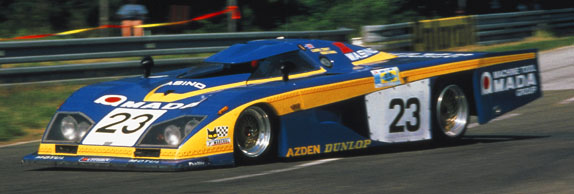A child's dream, the Dome-Zero story
The Dome company was founded in 1975 for the purpose of designing and building racecars. At some point along the way founder Minoru Hayashi decided to pursue the dream of a limited production super-car and thus began the Dome-Zero project.
Making its debut at the 1978 Geneva Auto Show, the prototype car took more than 2 years to build. According to those involved it was "a miserable process" with artisans from across Japan staying in hotels near Hayashi's shop in Osaka and working long nights to get the car done and ready for shipment to Switzerland for its debut. Four company employees paid the price in their marriages as a result of the struggle. Despite all of the hardship, the car was received with massive enthusiasm from the motoring press, fans, and potential investors.
 |
| The Dome-0 P2, #2 of 2 produced |
The car featured a "wedge" shape in profile, it was long, low, and impossibly sleek. It stood at just 38.6 inches tall, even shorter than a Ford GT40. It had pop-up headlights and beetle-wing doors, opening both upward and outward at an angle, away from the bodywork. The windshield was wide and flat, while the side glass was severely angular. The whole greenhouse had an almost pyramidal quality to its shape. There were additional slot-like windows in the doors to aid in visibility.
 |
| The Dome-0 P2 engine bay, showing it Nissan L-28 motor. |
Mechanically, a variety of parts from Japanese manufacturers were used including, the L28 inline 6 from the Nissan/Datsun 280zx, brakes from the Subaru Leone, the steering column from a Honda Accord, and internal door parts from the Toyota Celica of the day. It also used a 5-speed manual transmission sourced from Nissan.
In 1979 a "production" version of the car was rolled out in prototype form, shown in a wild lime green color with graphic elements in a darker shade of green. By this time, Toy makers were beating Hayashi's door down to ink licensing deals to produce miniatures of the design, which proved very profitable for the fledgling racecar company. The P2, as the new prototype was called, made a world tour of Auto Show appearances. It was even shown in the US at the Chicago and Los Angeles shows, respectively.
Hayashi hoped to meet a target price of $60,000 (USD) when the car came to market. However, despite a 3rd car being produced and a substantial amount of interest, investors never materialized. The company struggled to meet the strict requirements for road certification in their home country and lack of funding prevented them from homologation in other markets as well. As such, the road going version of the car never saw production and remained nothing but a marketing tool for the company.
This didn't stop Dome from developing a racing version of the car, however. A variant of the car was entered in the 24 hours of Le Mans in 1979 and 1980. Two LM versions were produced, called the Dome RL. The cars were a massive 16.4 feet long and featured a distinctive, partially enclosed cockpit with a half windscreen that terminated roughly halfway between the cowl and the front edge of the roof. It also had some of the best looking livery of the day, sponsored by Roland, the infamous Synthesizer maker.
 |
| The Dome-0 RL Le Mans racecar in Roland livery |
While the road-going version never made production, it lived on in the hearts and minds of fans. The Dome-Zero's image and likeness found a home on the walls and in the toyboxes of millions of kids worldwide throughout the 80's. Tamiya and Tomica made some of the nicest models, being plastic kits and diecast respectively. A new generation of car-crazy kids was introduced to the car in video games like Gran Turismo in the 90's and 2K's as well. It has become an enduring classic, a Japanese icon for its era.
All of this was fitting, of course, since the full name of Dome is "Kabushiki Kaisha Dōmu", which translates quite literally to "child's dream".
Sources:
Dome Company Ltd.
Road & Track
Dome Company Ltd.
Road & Track
 |
| The Dome-0 P2 |
 |
| The Dome-0 P2, top-rear view |
 |
| The Dome-0 P2 #2 |
 |
| The Dome-0 P2 #2 |
 |
| The original Dome-0 |
 |
| The Dome-0 P2 #2 |
 |
| The original Dome-0 |
 |
| The Dome-0 P2 |
 |
| The Dome-0 P2 |
 |
| The Dome-0 RL81 |
 |
| The Dome-0 RL80 |
Some bonus video links:
The History of Dome-0 - Alfa Guy 2
Dome construction (silent) - Dome Co. Ltd.
Proving ground footage (silent) - Dome Co. Ltd.
Osaka road testing (silent) - Dome Co. Ltd.






Comments
Post a Comment